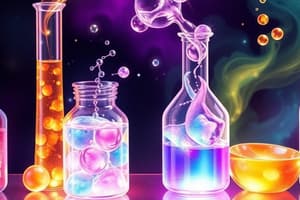Podcast
Questions and Answers
What characterizes a chemical property?
What characterizes a chemical property?
- It describes a substance's reaction with other substances. (correct)
- It remains unchanged regardless of environmental conditions.
- It can be observed without a chemical reaction.
- It is the appearance of a substance before any reaction.
Which of the following is an example of a chemical change?
Which of the following is an example of a chemical change?
- Iron rusting in the presence of oxygen. (correct)
- Boiling water to produce steam.
- Dissolving sugar in water.
- Melting ice into water.
What is the primary characteristic of chemical changes?
What is the primary characteristic of chemical changes?
- They result in the formation of one or more new substances. (correct)
- They only occur at elevated temperatures.
- They can be reversed by physical means.
- They do not alter the total mass of substances.
Which substance is classified as acidic?
Which substance is classified as acidic?
Which of the following best describes reactivity as a chemical property?
Which of the following best describes reactivity as a chemical property?
What role do reagents play in testing chemical properties?
What role do reagents play in testing chemical properties?
Which of the following elements is essential for oxygen transport in blood?
Which of the following elements is essential for oxygen transport in blood?
What type of bond is formed when electrons are shared between atoms?
What type of bond is formed when electrons are shared between atoms?
What distinguishes a compound from an element?
What distinguishes a compound from an element?
What is a characteristic property of compounds?
What is a characteristic property of compounds?
Which reaction type involves a compound breaking down into simpler substances?
Which reaction type involves a compound breaking down into simpler substances?
What is the correct formula for water?
What is the correct formula for water?
Which element is a common metal used in construction?
Which element is a common metal used in construction?
What type of change involves the formation of new substances?
What type of change involves the formation of new substances?
What is sodium chloride commonly known as?
What is sodium chloride commonly known as?
What is a characteristic feature of chemical changes?
What is a characteristic feature of chemical changes?
Which of the following is an example of a chemical change?
Which of the following is an example of a chemical change?
What best describes oxidation in terms of chemical changes?
What best describes oxidation in terms of chemical changes?
Which property distinguishes chemical changes from physical changes?
Which property distinguishes chemical changes from physical changes?
Which of these is NOT a type of chemical change?
Which of these is NOT a type of chemical change?
Why is it important to understand chemical properties in industrial processes?
Why is it important to understand chemical properties in industrial processes?
How is a chemical element defined?
How is a chemical element defined?
What does the atomic number of an element represent?
What does the atomic number of an element represent?
Which of the following describes a homogeneous mixture?
Which of the following describes a homogeneous mixture?
In the context of cooking, what type of change is the Maillard reaction?
In the context of cooking, what type of change is the Maillard reaction?
What characterizes a heterogeneous mixture?
What characterizes a heterogeneous mixture?
What defines a solution in chemistry?
What defines a solution in chemistry?
Which of the following is a characteristic of mixtures?
Which of the following is a characteristic of mixtures?
What role do elements and compounds play in environmental science?
What role do elements and compounds play in environmental science?
Flashcards are hidden until you start studying
Study Notes
Mixtures
- Mixtures are combinations of two or more substances where each substance retains its own chemical identity and properties.
- Mixtures are physically combined, not chemically bonded.
- Mixtures can be separated by physical means.
Types of Mixtures
-
Homogeneous Mixtures: Components are uniformly distributed and consistent throughout.
- Uniform appearance.
- Single phase (solid, liquid, or gas).
- Examples: Air, saltwater, solutions (sugar dissolved in water), alloys (brass).
-
Heterogeneous Mixtures: Components are not uniformly distributed.
- Non-uniform appearance.
- Multiple phases.
- Examples: Salad, suspensions (muddy water), colloids (milk, fog).
Solutions
- A specific type of homogeneous mixture.
- One substance (solute) is dissolved in another (solvent).
- Solutions have a uniform composition and properties throughout.
- Examples: Sugar dissolved in water.
Chemical Properties
- Describe how a substance interacts with other substances and its potential to undergo chemical changes.
- Intrinsic to the substance and can only be observed during a chemical reaction.
- Examples: Flammability, reactivity, acidity or basicity, oxidation state.
Chemical Changes
- Processes where substances undergo transformations to form new substances with different chemical properties.
- Involve the breaking and forming of chemical bonds.
- Examples: Combustion, oxidation, acid-base reactions, decomposition.
Characteristics of Solutions
- Solutions have a uniform composition, meaning the solute is evenly distributed throughout the solvent.
- They exist in a single phase, which can be solid, liquid, or gas.
- Solute particles are not visible to the naked eye as they are dispersed at the molecular or ionic level.
Components of Solutions
- The solute is the substance dissolved, typically present in a smaller amount than the solvent.
- The solvent is the substance that dissolves the solute, typically present in a larger amount.
Types of Solutions
- Solid Solutions: A homogeneous mixture with the solute dissolved in a solid solvent.
- Examples: Alloys like bronze (copper and tin) and steel (iron and carbon).
- Liquid Solutions: A homogeneous mixture with the solute dissolved in a liquid solvent.
- Examples: Saltwater (salt dissolved in water) and sugar water.
- Gas Solutions: A homogeneous mixture with gases dissolved in other gases.
- Examples: Air, which is a mixture of gases, and carbonated beverages (carbon dioxide dissolved in liquid).
Properties of Solutions
- Concentration: The amount of solute in a given amount of solvent or solution.
- Can be expressed as molarity, molality, or percentage.
- Molarity (M): Moles of solute per liter of solution.
- Molality (m): Moles of solute per kilogram of solvent.
- Percentage Concentration: The mass or volume percentage of solute in the solution.
- Solubility: The maximum amount of solute that can dissolve in a given amount of solvent at a specific temperature and pressure.
- Influenced by temperature, pressure, and the nature of the solute and solvent.
- Solubility generally increases with temperature for solid solutes but decreases for gases.
- Solubility of gases increases with pressure (Henry's Law).
- Saturation: A solution is saturated when it contains the maximum amount of solute that can dissolve at a specific temperature and pressure.
- Saturated Solution: Contains the maximum amount of solute that can dissolve.
- Unsaturated Solution: Contains less solute than the maximum amount that can dissolve.
- Supersaturated Solution: Contains more solute than the maximum amount that can dissolve, achieved by changing conditions like temperature.
Other Types of Mixtures
-
Suspensions: Heterogeneous mixtures where solid particles are dispersed in a liquid, but settle out over time.
- Particles are relatively large and visible.
- Examples: Muddy water, orange juice with pulp.
-
Colloids: Heterogeneous mixtures where particles are dispersed throughout another substance, but are small enough that they do not settle out.
- Particles are intermediate in size, between solutions and suspensions.
- Examples: Milk, fog, and gelatin.
Studying That Suits You
Use AI to generate personalized quizzes and flashcards to suit your learning preferences.





